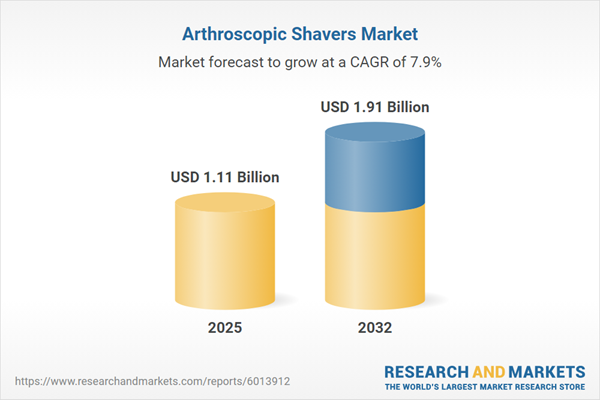Speak directly to the analyst to clarify any post sales queries you may have.
The arthroscopic shavers market is advancing rapidly, driven by sustained clinical innovation and the growing global adoption of minimally invasive orthopedic procedures. Senior decision-makers face an evolving landscape defined by regulatory, operational, and strategic considerations that will shape long-term outcomes for both manufacturers and healthcare providers.
Market Snapshot: Arthroscopic Shavers Market Opportunity
The Arthroscopic Shavers Market grew from USD 1.03 billion in 2024 to USD 1.11 billion in 2025. It is expected to continue growing at a CAGR of 7.92%, reaching USD 1.91 billion by 2032. This market expansion is underpinned by advancements in minimally invasive techniques, rising demand for outpatient orthopedic interventions, and increased investment in digital health solutions. Market leaders are optimizing both reusable and single-use offerings to address evolving needs in surgical performance, safety, and cost management.
Scope & Segmentation
- Device Type: Reusable devices, Single-use solutions
- End User: Ambulatory Surgical Centers, Hospitals, Clinics
- Application: Ankle, Hip, Knee, Shoulder joint procedures
- Blade Type: Fluted, Hooked, Serrated blades
- Sales Channel: Direct sales, Distributor partnerships
- Technology: Conventional mechanical systems, Smart platforms, AI-enabled features, Robotic-assisted technologies
- Geographies:
Americas: North America (United States, Canada, Mexico), Latin America (Brazil, Argentina, Chile, Colombia, Peru)
Europe, Middle East & Africa: Europe (United Kingdom, Germany, France, Russia, Italy, Spain, Netherlands, Sweden, Poland, Switzerland), Middle East (United Arab Emirates, Saudi Arabia, Qatar, Turkey, Israel), Africa (South Africa, Nigeria, Egypt, Kenya)
Asia-Pacific: China, India, Japan, Australia, South Korea, Indonesia, Thailand, Malaysia, Singapore, Taiwan - Key Companies: Stryker Corporation, Smith & Nephew plc, Zimmer Biomet Holdings Inc., DePuy Synthes Inc., Arthrex Inc., CONMED Corporation, KARL STORZ SE & Co. KG, Richard Wolf GmbH, B. Braun Melsungen AG, Medtronic plc
Key Takeaways for Senior Decision-Makers
- The shift towards arthroscopic shavers featuring enhanced ergonomics, advanced blade technologies, and improved data integration is setting new benchmarks for procedural success.
- Strategic collaborations with technology firms and healthcare providers are accelerating the adoption of AI analytics and robotics-assisted procedures.
- Growing emphasis on outpatient procedures is prompting manufacturers to optimize for swift turnaround, streamlined sterilization, and procedural safety across diverse care environments.
- Product differentiation now relies on the ability to meet specific clinical requirements, such as joint anatomy or procedural complexity, while balancing reusable and disposable offerings.
- Providers in mature markets prioritize the latest digital advancements, whereas emerging markets are expanding the base for conventional and reusable shaver systems to address volume growth and resource constraints.
- Sales and distribution strategies play a critical role, with direct engagement cultivating stronger clinical partnerships, while distributors contribute to rapid regional access.
Tariff Impact: Addressing 2025 United States Tariff Adjustments
The introduction of new US tariff measures in 2025 has added complexity to global supply chains for arthroscopic shaver manufacturers. Companies leveraging vertically integrated operations are better positioned to manage additional duties, while those dependent on outsourced components are reassessing contract structures, supplier locations, and end-to-end logistics. Resilience planning—including regional sourcing, inventory management, and dynamic cost modeling—remains critical to minimizing operational disruptions.
Methodology & Data Sources
This report utilizes a rigorous blend of secondary data aggregation: scientific literature, regulatory filings, patent databases, and policy documents. Primary research includes structured interviews with orthopedic surgeons, engineers, and procurement professionals, alongside international surveys of surgical facilities. Advanced statistical models and scenario analyses support robust data validation and actionable recommendations.
Why This Report Matters
- Provides senior leaders with actionable analysis integrating technology trends, regulatory shifts, and commercial strategies specific to arthroscopic shavers.
- Enables benchmarking of current and emerging competitors, empowering informed investment and partnership decisions across key regions.
- Supports operational strategy through evidence-based insights into tariff impacts, supply chain resilience, and clinical adoption patterns.
Conclusion
The arthroscopic shavers market is defined by its dynamic blend of innovation, regulatory adaptation, and emerging clinical practice trends. Executives can leverage this report to anticipate market shifts, streamline operational priorities, and capture value within a competitive global landscape.
Additional Product Information:
- Purchase of this report includes 1 year online access with quarterly updates.
- This report can be updated on request. Please contact our Customer Experience team using the Ask a Question widget on our website.
Table of Contents
3. Executive Summary
4. Market Overview
7. Cumulative Impact of Artificial Intelligence 2025
Companies Mentioned
The companies profiled in this Arthroscopic Shavers market report include:- Stryker Corporation
- Smith & Nephew plc
- Zimmer Biomet Holdings, Inc.
- DePuy Synthes, Inc.
- Arthrex, Inc.
- CONMED Corporation
- KARL STORZ SE & Co. KG
- Richard Wolf GmbH
- B. Braun Melsungen AG
- Medtronic plc
Table Information
| Report Attribute | Details |
|---|---|
| No. of Pages | 189 |
| Published | October 2025 |
| Forecast Period | 2025 - 2032 |
| Estimated Market Value ( USD | $ 1.11 Billion |
| Forecasted Market Value ( USD | $ 1.91 Billion |
| Compound Annual Growth Rate | 7.9% |
| Regions Covered | Global |
| No. of Companies Mentioned | 11 |









